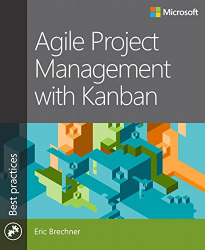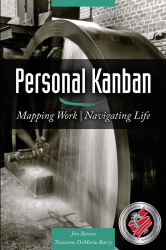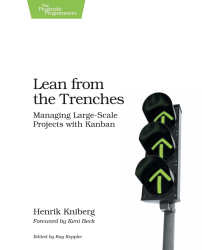In the context of Lean practices, Kanban is a visual tool for managing flow of information or work items. It is flexible enough to introduce into an existing process without having to replace that process. It is also very compatible with Agile methods and is commonly used as an Agile entry point in project management. It helps in the management of projects by visualizing workflow, limiting work in process, and improving the flow. With its increased popularity, more books are now available about Kanban and how organizations can use it.
Top Kanban Project Management Books
Kanban is an Agile framework used in many software projects. With historical origins from Lean manufacturing, it is a flexible approach that is applicable to projects and product management in many other industries. Here are five Kanban project management books we highly recommend about the subject.
Agile Project Management with Kanban

Agile Project Management with Kanban is for practicing software development professionals who may be part of a team or working alone. It is for professionals in the role of software analyst, project manager, developer, tester, project lead, development manager, or even someone who aspires to be any of these.
The book includes 160 pages divided in nine chapters complete with diagrams, tables, charts, worksheets, Q&A sections, and troubleshooting sections. The contents progress similar to how a feature team goes through a software project. Chapter 1 shares how the team can approach management and gain consent to use the Kanban methodology. The next chapters include topics about how to get started with Kanban, how to fill, arrange, and estimate their backlog, and how to adapt or evolve to Kanban from using other methodologies.
Author Eric Brechner is a Microsoft professional with more than two decades experience in the software industry. The book came out in March 2015 and has remained in Amazon’s top 20 books in the agile project management category.
Kanban: Successful Evolutionary Change for Your Technology Business

Published in April 2010, Kanban: Successful Evolutionary Change for Your Technology Business has been among the best-selling Agile books in Amazon. It is currently in the top 5 in both engineering project management and technical project management categories.
The book’s 278 pages are divided into four parts, namely, introduction to the Kanban method, its benefits, how to implement it, and making improvements. The four parts are further divided into 20 chapters, which includes discussion on what the Kanban method is, the benefits of a continuous improvement culture, how to map the value stream, and setting work-in-progress limits. The book is the result of the author’s quest as an agile development manager to search for a method that will support sustainable pace.
David J. Anderson is the founder of Kanban University, co-creator of the Kanban Maturity Model, and author of books for modern business. He has over 30 years of experience working in the high-technology industry.
Personal Kanban: Mapping Work | Navigating Life

The authors describe Personal Kanban as a productivity tool, that by limiting our work-in-progress, we are able to accomplish more. It is an efficiency tool that encourages us to find ways to work with the least effort. And it is an effectiveness tool that helps us visualize our options so we can make informed decisions.
The book has 276 pages and contains an introduction, eight chapters, and two appendices. It starts with the concept that our professional, personal, and social lives should not be treated separately because it results in unsustainable competition for our time. Personal Kanban is a simple and visual mechanism to help us manage ourselves, but also allows us to share our work, goals, and aspirations to others.
Jim Benson is the CEO of Modus Cooperandi, a provider of coaching, training, and consulting services to help clients build systems that solve their problems. He is a pioneer in applying Lean and Kanban to knowledge work.
Tonianne DeMaria Barry is a partner at Modus Cooperandi, cofounder of Kaizen Camp, an award-winning author, and systems thinker. She works with clients globally to create healthy environments where people thrive and value is realized.
Lean from the Trenches: Managing Large Scale Projects with Kanban

Lean from the Trenches comes in two parts. The first part, composed of 16 short chapters, is about a case study of an actual software project for the Swedish police. It details in sequence what the project was about, specific challenges encountered, how a team of 60 members handled the challenges, and what they learned along the way.
The second part is a closer look at the techniques employed that the reader can independently approach. It starts with an introduction into Agile, Lean, Scrum, XP, and Kanban. The discussion goes on into automating testing, estimating, and cause-effect diagrams. The book is for team leads, managers, coaches, change agents, and anyone involved in software development, Lean product development, and team collaboration. The book is about practice and not theory, so anyone, including those new to Agile or Lean, can appreciate it.
Author Henrik Kniberg is the owner and Agile/Lean coach of Crisp, an IT consultancy based in Stockholm. Having previously worked on Spotify and LEGO, Kniberg has a mix of development and management experience, applying Agile and Lean principles to help companies improve.
Kanban from the Inside

Kanban from the Inside: Understand the Kanban Method, connect it with to what you already know, introduce it with impact. The title is a summary of the three parts of the book’s 270 pages, further divided in 23 chapters. Readers with some knowledge of software development will find it easier to read, but this is not a prerequisite.
The first part, composed of 10 chapters, presents the Kanban Method through a system of nine values. The second part discusses several models like Systems Thinking, Theory of Constraints, and Agile in the next seven chapters. It is about a core practice in Kanban of using models or bodies of knowledge outside of its domain. This practice encourages practitioners to explore something that they can integrate. The last six chapters is about implementing Kanban in an organizational context.
Mike Burrows is the founder of Agendashift, a change management consultancy that helps leaders and team members as their organization transforms from the inside. He is a pioneer in applying the values model of the Kanban Method, and has prior experiences as global development manager, executive director, IT director, and interim manager.
Additional Kanban References
It is fortunate that more books about Kanban have become available in the last few years. The following five additional references discuss Kanban principles or practices in various applications. These books range from basic introduction, implementation solutions, to advanced reference guides.
Practical Kanban: From Team Focus to Creating Value
Practical Kanban from Dr. Klaus Leopold offers pragmatic advice and practical solutions that can arise when using Kanban. In his experience of designing and implementing Kanban systems, there are typical problems that continually occur over time. This book is a catalog of solutions to these problems and possible other issues.
Kanban in Action
Kanban in Action from Markus Hammarberg and Joakim Sunden is a fun yet insightful way to learn and understand what Kanban is. It is an introduction book that emphasizes how Kanban, as a software design tool, creates understanding for all stakeholders by simply allowing people to see the work and visualize the process so they can manage flow.
Kanban Maturity Model, Coaches’ Edition
Kanban Maturity Model, Coaches’ Edition: A Map to Organizational Agility, Resilience, and Reinvention by David J. Anderson and Teodora Bozheva. This book is for consultants, coaches, corporate change agents, and managers who helps transition enterprises to have a more improved operations and service delivery. It discusses the seven levels of organizational maturity against the six general practices of Kanban.
The Basics of Kanban: A Popular Lean Framework
The Basics of Kanban: A Popular Lean Framework by Aditi Agarwal is the third book in a series titled The Basics of Customer-First Product Management. This book provides the reader a reference guide on Kanban. It covers definitions and descriptions, principles and practices, metrics, comparison against Scrum, integration in Scrumban, and several case studies.
Essential Kanban Condensed
Essential Kanban Condensed by David J. Anderson and Andy Carmichael is a concise book of 102 pages. It provides essential rather than exhaustive discussion of what Kanban is and how it is applicable. It is a resource to help professionals how to get started and also points them where to look to find out more about Kanban.
Ready to start your Kanban journey?
The goal of Kanban is continuous improvement of processes. It is less disruptive so those interested can begin exactly where they are currently at. You can begin with any of our recommended books depending on your present knowledge, exposure, and experience with Kanban.


